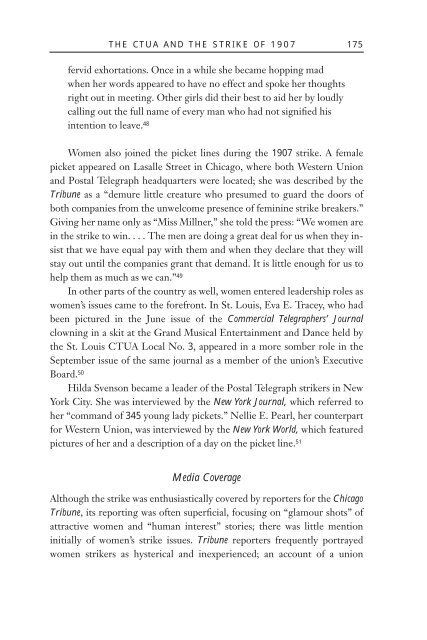My Sisters Telegraphic: Women in the Telegraph Office ... - Monoskop
My Sisters Telegraphic: Women in the Telegraph Office ... - Monoskop
My Sisters Telegraphic: Women in the Telegraph Office ... - Monoskop
Create successful ePaper yourself
Turn your PDF publications into a flip-book with our unique Google optimized e-Paper software.
THE CTUA AND THE STRIKE OF 1907 175<br />
fervid exhortations. Once <strong>in</strong> a while she became hopp<strong>in</strong>g mad<br />
when her words appeared to have no effect and spoke her thoughts<br />
right out <strong>in</strong> meet<strong>in</strong>g. O<strong>the</strong>r girls did <strong>the</strong>ir best to aid her by loudly<br />
call<strong>in</strong>g out <strong>the</strong> full name of every man who had not signified his<br />
<strong>in</strong>tention to leave. 48<br />
<strong>Women</strong> also jo<strong>in</strong>ed <strong>the</strong> picket l<strong>in</strong>es dur<strong>in</strong>g <strong>the</strong> 1907 strike. A female<br />
picket appeared on Lasalle Street <strong>in</strong> Chicago, where both Western Union<br />
and Postal <strong>Telegraph</strong> headquarters were located; she was described by <strong>the</strong><br />
Tribune as a “demure little creature who presumed to guard <strong>the</strong> doors of<br />
both companies from <strong>the</strong> unwelcome presence of fem<strong>in</strong><strong>in</strong>e strike breakers.”<br />
Giv<strong>in</strong>g her name only as “Miss Millner,” she told <strong>the</strong> press: “We women are<br />
<strong>in</strong> <strong>the</strong> strike to w<strong>in</strong>. . . . The men are do<strong>in</strong>g a great deal for us when <strong>the</strong>y <strong>in</strong>sist<br />
that we have equal pay with <strong>the</strong>m and when <strong>the</strong>y declare that <strong>the</strong>y will<br />
stay out until <strong>the</strong> companies grant that demand. It is little enough for us to<br />
help <strong>the</strong>m as much as we can.” 49<br />
In o<strong>the</strong>r parts of <strong>the</strong> country as well, women entered leadership roles as<br />
women’s issues came to <strong>the</strong> forefront. In St. Louis, Eva E. Tracey, who had<br />
been pictured <strong>in</strong> <strong>the</strong> June issue of <strong>the</strong> Commercial <strong>Telegraph</strong>ers’ Journal<br />
clown<strong>in</strong>g <strong>in</strong> a skit at <strong>the</strong> Grand Musical Enterta<strong>in</strong>ment and Dance held by<br />
<strong>the</strong> St. Louis CTUA Local No. 3, appeared <strong>in</strong> a more somber role <strong>in</strong> <strong>the</strong><br />
September issue of <strong>the</strong> same journal as a member of <strong>the</strong> union’s Executive<br />
Board. 50<br />
Hilda Svenson became a leader of <strong>the</strong> Postal <strong>Telegraph</strong> strikers <strong>in</strong> New<br />
York City. She was <strong>in</strong>terviewed by <strong>the</strong> New York Journal, which referred to<br />
her “command of 345 young lady pickets.” Nellie E. Pearl, her counterpart<br />
for Western Union, was <strong>in</strong>terviewed by <strong>the</strong> New York World, which featured<br />
pictures of her and a description of a day on <strong>the</strong> picket l<strong>in</strong>e. 51<br />
Media Coverage<br />
Although <strong>the</strong> strike was enthusiastically covered by reporters for <strong>the</strong> Chicago<br />
Tribune, its report<strong>in</strong>g was often superficial, focus<strong>in</strong>g on “glamour shots” of<br />
attractive women and “human <strong>in</strong>terest” stories; <strong>the</strong>re was little mention<br />
<strong>in</strong>itially of women’s strike issues. Tribune reporters frequently portrayed<br />
women strikers as hysterical and <strong>in</strong>experienced; an account of a union

















